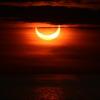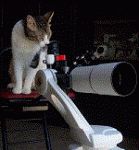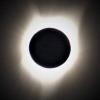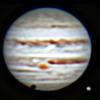
Cosmic Challenge: Seyfert's Sextet
#1

Posted 06 July 2020 - 03:02 PM
Click here to view the article
- jeremiah2229 and Redbetter like this
#2

Posted 11 July 2020 - 12:46 AM
I've only seen three brightest members in my 18" (not too difficult), but Uwe Glahn managed to glimpse five in a 16". It is a fun challenge to try and bust the knot apart.
The faintest two members (based on observations in a 48") of the Sextet are not physical members -- namely, the tidal plume and the small background galaxy
- PhilH likes this
#3

Posted 13 July 2020 - 06:18 AM
Thanks for the guide, Phil. I had this one on my list for this month after doing other Serpens Hicksons last month.
Last night I gave this a shot with the 20" in 21.6 MPSAS conditions. The three brightest members popped out immediately. In many ways each of these three looks larger than its published size, probably because each has relatively high surface brightness. Stellar/semi-stellar cores were seen in all three at 278x (roughly the seeing limit at the time.)
To my surprise, I found the 6027E plume to be readily seen in averted vision. While it was subtle, it was also quite recognizable. The brighter central portion of it reminded me of a faint extended arm. I couldn't see anything directly, but there was enough separation from 6027 that this faint arm and its orientation stood out in averted vision.
6027D proved to be a challenge and I am not sure why. It might have had something to do with the seeing, or the brighter galaxies nearby, but I could not get a definite fix on it. I was seeing something separate from the glow of 6027 at moments, but not coherent and persistent enough to satisfy. I tried 357, 417, and 500x, and tried using my other eye, but none of it helped. I would like to try it in better seeing.
6027C was visible in averted vision, much like a ghostly low surface brightness near edge on. While it was AV only, it could be held well enough after a time, and the orientation remained consistent when seen.
In checking Wikisky I noticed another tiny PGC to the west, PGC 1635684. I didn't have a chart made for it, but knew its relative orientation to a 14 and 16.6 mag star, so I gave it a go. The galaxy has a green magnitude of about 17.2. I was getting a hit of something in the general vicinity, and roughly the right size, but I could not pin it down well enough to say I definitely had it. Had I made a chart showing the other 17.1 mag star beyond it, I probably could have nailed it down.
- PhilH and sgottlieb like this
#4

Posted 13 July 2020 - 12:10 PM
I'm not surprised NGC 6027D (=HCG 79E) was challenging. It was really small in the 48" (estimated as 6" diameter) and barely off the south side of HCG 79B (just 13" between center). So although it wasn't difficult, it wasn't immediately obvious either.
By the way, Seyfert's original letter designations in his paper "A Dense Group of Galaxies in Serpens" and shown in Phil's article was not followed by Hickson, who skipped the tidal plume (NGC 6027E). So, sometimes I've seen the identifications confused.
- PhilH and Redbetter like this
#5

Posted 13 July 2020 - 06:09 PM
Steve,
Yes, the Hickson/NGC designations are a jumble. I have used Phil's above to try to be consistent. It is a challenge when some are using Hickson designations, some NGC letters and the NGC numbers differ depending on source. In addition to Phil's guide, Wikisky has one (same as LEDA I believe), Reiner Vogel has Hickson's(I think)...I can't figure out what Uranometria is trying to show, it is tiny and seems at odds with the others--I haven't tried to sort based on DSFG's coordinates. I haven't checked NED. I can't keep them straight...I would have to spend a few hours printing each chart out for each source and each designation (6027's and HCG 79's separately in each source) and make a cross reference table for all of them by source. But I think I am just going to attach Phil's chart to my log.
I had a clean sweep on Hickson 85 in Draco last night. Those tiny C & D components were immediately picked up in averted vision at 278x, simultaneously, and could be held that way. They seemed to have good surface brightness considering how dim their stated magnitudes are (mid 17 B mags.) I would put them at somewhere around 16.5+ visual. It doesn't hurt that this is the darkest section of sky for me and seeing was peaking at the time. The contrast was better than it had been on Hickson 79. Preceding a bit to the WSW is a field star with a galaxy just south of it, easily seen. And further to the west of HCG 79 is CGCG 341-9 with a dim field star on the east body of the galaxy, following the core. I was able to pick up a tough PGC 2754094 well south of the HCG. But the reason for mentioning those is the interesting and difficult UGC 11377 that is north of the bright (9th mag) field star. This galaxy was very difficult to see, somewhat more so than the elongated NGC 6027C had been. Mostly I saw the long N/S line in averted vision, but as glimpses sweeping back and forth. Eventually I found that I could hold the slightly thicker central region in AV, but when I did I could not see the longer strand. Anyway, this last galaxy made for a good comparison visually as it shared some aspects but differed in others.
- PhilH likes this
















